Dear reader: This article contains links to products and services that I may be compensated for, at no extra cost to you.
Lima is often an afterthought on visitors’ Peru itinerary. Most pass through the Peruvian capital’s airport en route to Cusco, or spend a night in a hotel near the airport if they have to.
I’m here to tell you that you absolutely should spend two days in Lima! This sprawling city was once Pizarro’s capital of Spanish South America (you can see his skeleton while you’re there!) Prepare to immerse yourself in impressive colonial architecture and to eat like you never have before – some of the world’s top restaurants are here.
Two days was the perfect amount of time for me. I devoted the first to the gorgeous UNESCO historic city center and a museum or two. Then I spent the second exploring the ritzy dining district Miraflores and walking the clifftop paths of El Malecón to bohemian Barranco.
I recommend visiting Lima at the end of your trip, so you are a little more used to Peru before you tackle this Los Angeles-sized megacity. I did my Lima visit after spending almost three weeks in Cusco, the Sacred Valley, and doing the Inca Trail to Machu Picchu.
Below I will share exactly how I executed my Lima two-day itinerary after doing loads of research and planning.
Table of Contents
Lima Itinerary Quick Tips
- Lima in summer (December to April) is warm and pleasant, so you can consider visiting the beach. From May to November, the temperature can be a little cooler and the sky is almost always gray or foggy. It’s always humid.
- I spent two full days in Lima, which means I actually booked three nights.
- I used an Airalo eSIM for my trip and it worked extremely well. No need to worry about buying a SIM card when I arrived, super cheap, and it worked as soon as the plane landed! Just make sure your phone is compatible before getting one.
- Arriving at Lima Airport from Cusco, I caught Taxi Green (watch for the taxi stalls as soon as you enter the arrivals hall) for 65 soles to Miraflores, which is considered a safe, upscale neighborhood with lots of famous restaurants.
- I stayed at La Casona Azul Guesthouse (see on Booking / Agoda / TripAdvisor), a guesthouse in a lovely Lima house with garden and rooftop patio. If you stay there, make sure to give the address, because there’s another place in Lima with the same name.
- If you want to eat at one of Lima’s famous Michelin restaurants, you’ll need to research and book it months in advance. But don’t worry if you don’t – even the local eateries and mid-range restaurants have extremely high quality and often very photogenic food.
- While some people have reported issues with Ubers and regular taxis in Lima, I caught a few of both with no issue.
- Going back to the airport, I caught an Uber for a similar price to my arrival with Taxi Green. You can also use Taxidatum, which I had a good experience with in Cusco.
Lima Day 1: Historic Center
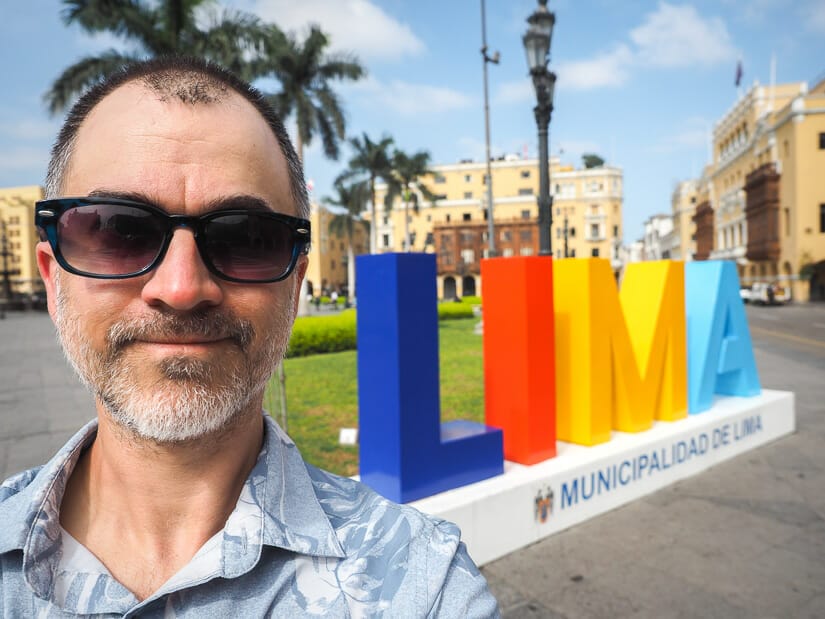
I decided to visit the historic center on my first day. My decision was affected by the fact that one sight I wanted to visit, Huaca Pucclana pyramid in Miraflores (which I’ll cover on Day 2), is only open on certain days of the week. You can see their opening days and book a spot (the tour is mandatory) here.
Lima’s Historic Center is a UNESCO World Heritage Site. Francisco Pizarro founded it as the “City of Kings” in 1535, and it remained the economic, polital, and religious capital of Spanish South America for centuries.
Today, the district is filled with impressive colonial palaces, cathedrals, convents, squares, and monuments. I must say I was in awe at the grandeur of it all from the moment I arrived!
Morning
After breakfast at my hotel, I caught an Uber to the historic district in Lima. I proceeded to embark on a whirlwind tour of over a dozen squares, churches, and other historic buildings I had bookmarked before my trip. Below, I’ll only introduce the ones I enjoyed most.
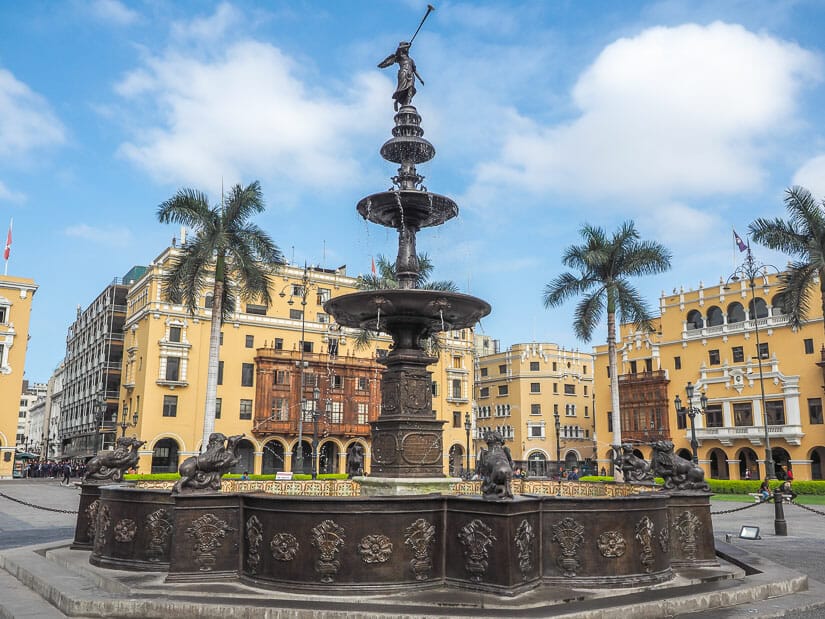
Your visit should naturally start at the Plaza Mayor de Lima (Plaza de Armas). Pizarro established this 140-square meter square to be the center of the continent. The Spanish executed their opponents in the square.
In 1821, independence from Spain was called here. At the center of the square, there’s a bronze angel fountain (built 1651) with trumpet facing north.
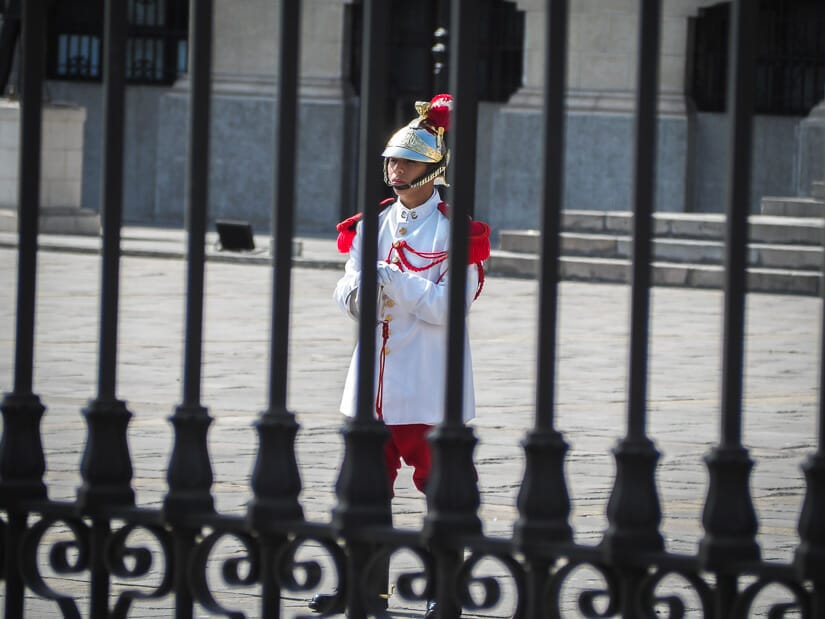
The square is surrounded by awe-inspiring architecture. To the north is the Palacio de Gobierno (Casa de Pizarro), the government palace and former home of Pizarro himself. Tours are by reservation only, but you can see the changing of the guards at noon.
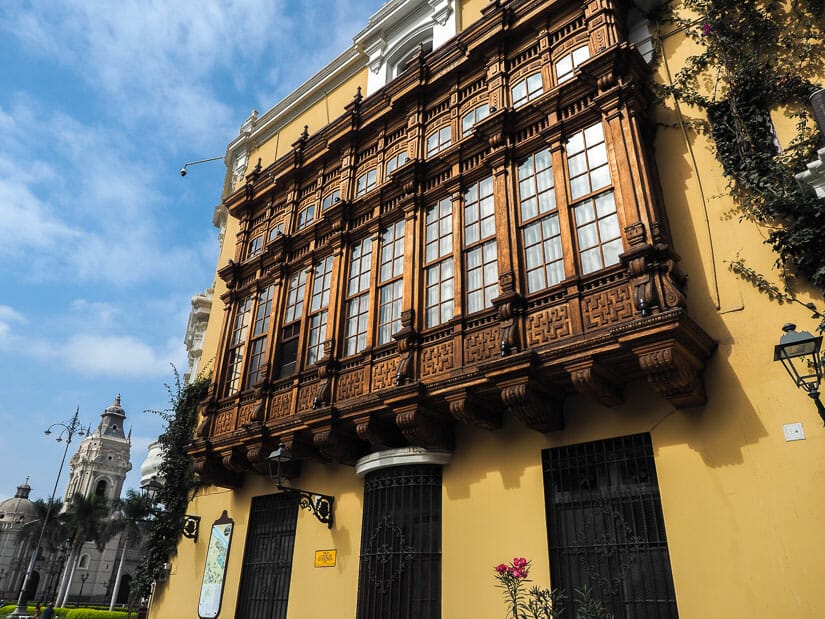
To the west is the Palacio Municipal (City Hall) in yellow. Other buildings with a similar style line the south side of the plaza.
If you’re wondering where I took my LIMA sign pictures, I found the colorful one (the cover image of this article and another with me in it above) on the northwestern side of the square, across from Palacio Municipal, while the grassy one (image below) is in Plaza Perú just across the street.
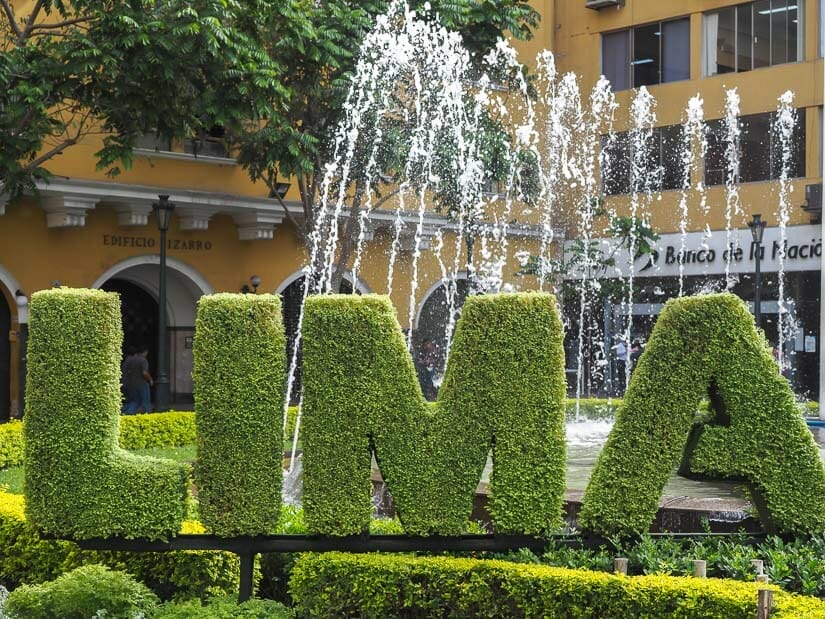
The east side of the square is dominated by the Catedral de Lima (Lima Cathedral) with its twin towers and the connected Archbishop’s Palace of Lima (Palacio Arzobispal de Lima). The Cathedral is unmissable, so start there – it opens at 9 AM.

Pizarro founded Lima Cathedral as the city’s first church in 1535 – it has been rebuilt many times since then. And here’s the best part – the remains of Pizarro himself can be seen inside! You can’t miss the skeleton – it’s in a small side chapel to the right just after you enter.
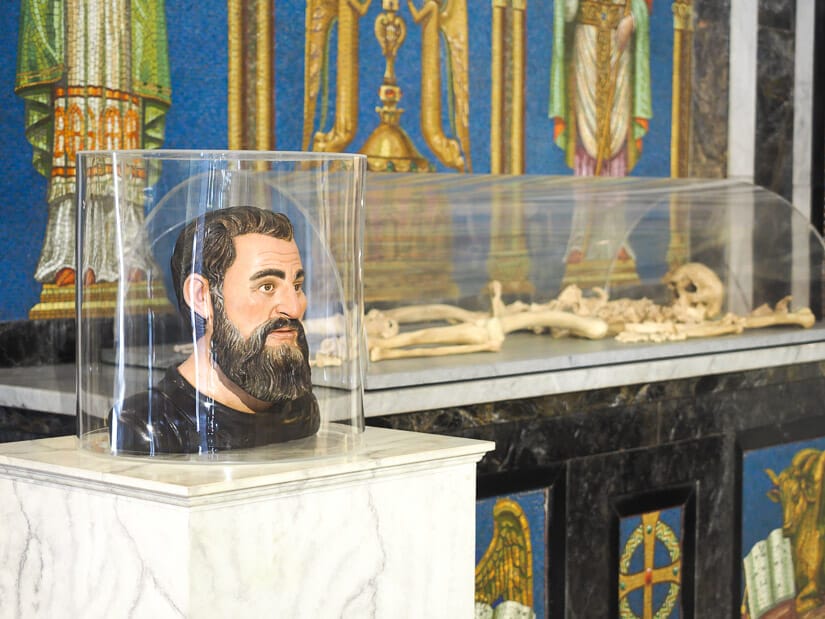
Besides that highlight, the Cathedral is as beautiful as you might expect. It’s a hodgepodge of styles, with Baroque façade, renaissance portal, neoclassical bell towers, and ornate interior. I saw impressive paintings and statues, ornate choir stalls, mighty altars, and more bones in the underground crypt.
Surprisingly, after not being allowed to take photos in any of the churches in Cusco, I was pleased to find that photography is allowed in Lima Cathedral (no flash). Entry is 10 soles.
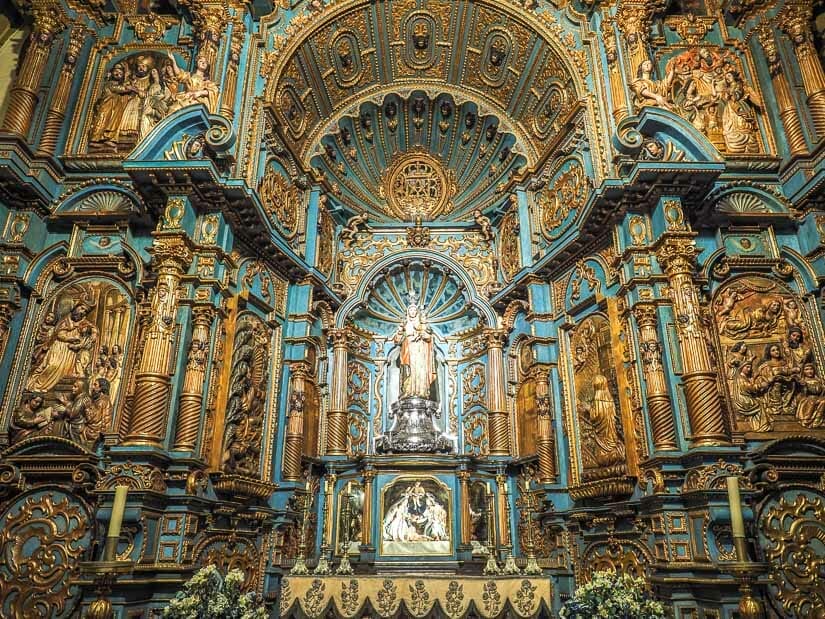
After the Cathedral, head directly to Convento de San Francisco de Lima, a short walk to the northeast of the plaza. This is another spot you won’t want to miss.
One of the largest convents in Latin America, San Francisco Convent is a Franciscan monastery and church especially famous for its expansive catacombs and gothic vibes. You’ll need to join a tour here, which is included in the entrance fee (15 soles, 30 to 45 minutes, they begin when there are enough people).
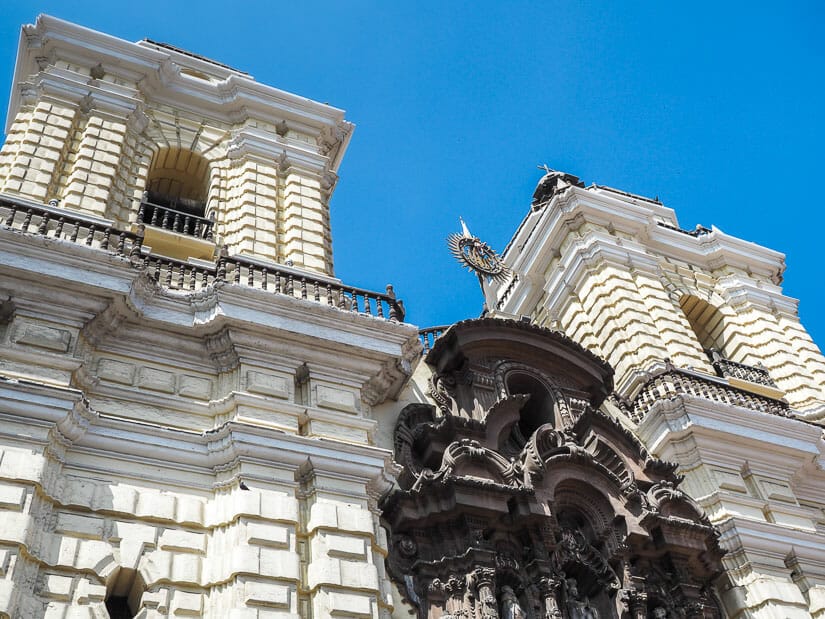
Sadly, you can’t take photos on the tour or anywhere inside. On my tour, I saw a library with 20,000 antique books, beautiful tiled cloisters, original paintings that were revealed after earthquake damage but with their faces mysterious scratched out, and a Last Supper painting with indigenous elements (not the same as the famous one in Cusco where they’re eating guinea pig).
But the climax of the tour was when we descended into the catacombs. We passed through narrow passages filled with crypts and human bone arrangements. Some 25,000 people are interred here! One circular crypt in particular was 8 meters deep, and filled with bones up to 5 meters.
If you’re claustrophobic, you may not love this experience. Bring some coins to tip the guide at the end.
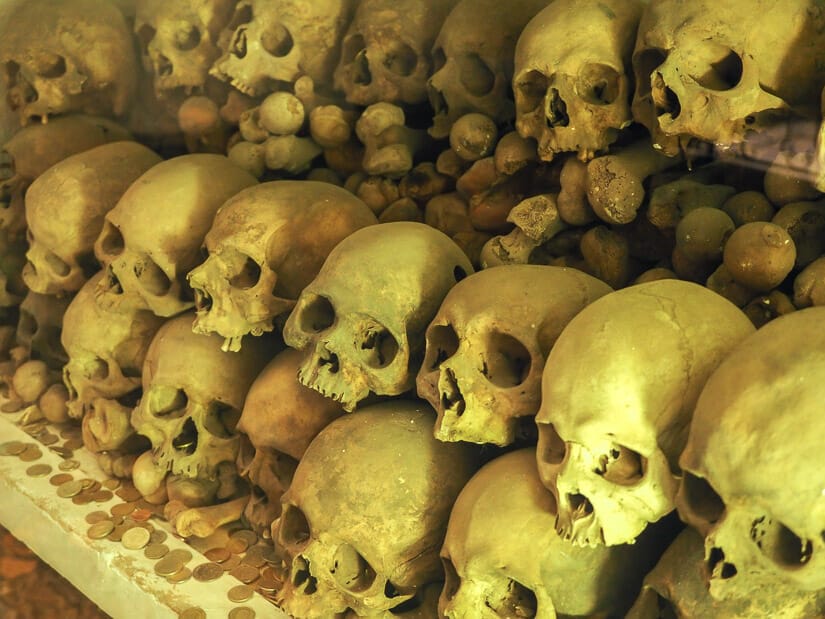
At this point, if you need a snack, the street in front of San Francisco Convent, called Jr. Lampa, is famous for its churros. I recommend Churros San Francisco, which sells them in three flavors: pastry cream, manjar blanco, and chocolate.
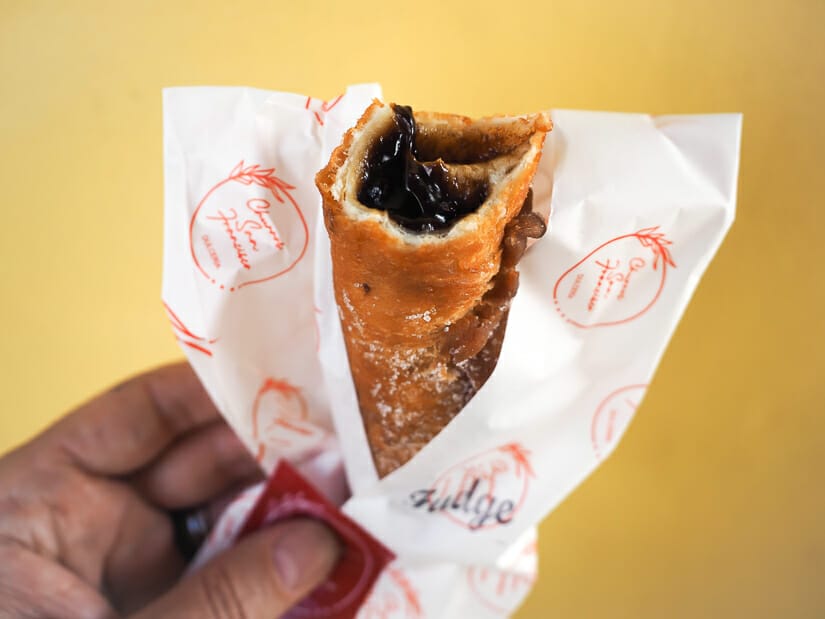
If you’re ready for lunch, I personally recommend Restaurante Cordano. This is a historic restaurant-bar facing the side of the Palacio de Gobierno. An Italian immigration opened it in 1905 and it is considered Lima’s oldest bar.
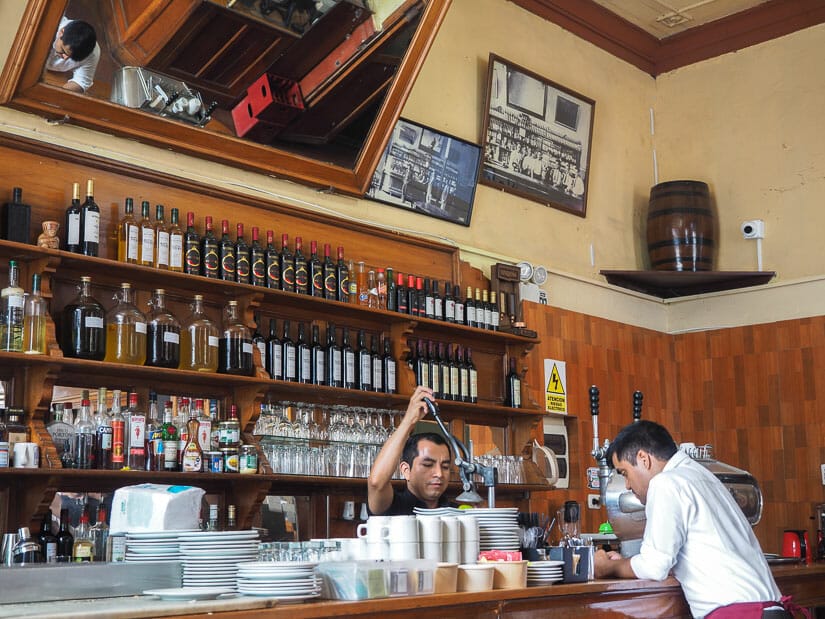
The vast menu at Cordano spans Peruvian, Creole, Chinese, and their famous Butifarra sandwiches. I went for a filling meal of tacu tacu (a patty made from beans and rice) and fish with salsa de mariscos (seafood sauce), with a slushy Maracuyá (passion fruit) juice.
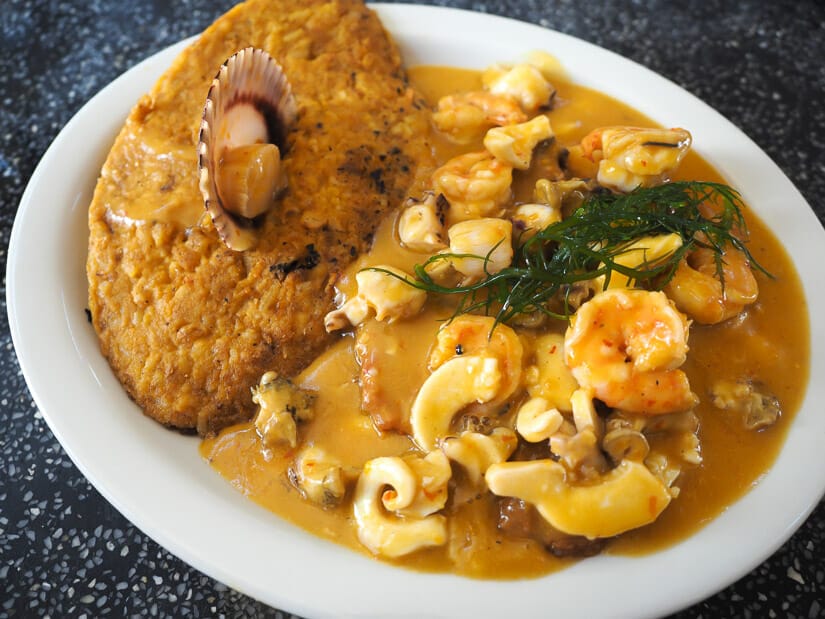
If you want to start drinking early, go for a pisco cocktail at Museo del Pisco on the same street but closer to the plaza. It’s a bar, not a museum. Besides their numerous pisco-based cocktails, you can get a pisco sour made with one of their pisco macerations (pisco with added flavors – you’ll see the colorful liquids in jars behind the bar).
The cardamom-infused pisco sour I had at Museo del Pisco in Cusco was my favorite cocktail in all of Peru. At the Lima location, I tried a coca pisco sour because, well, you could never get that in my country!
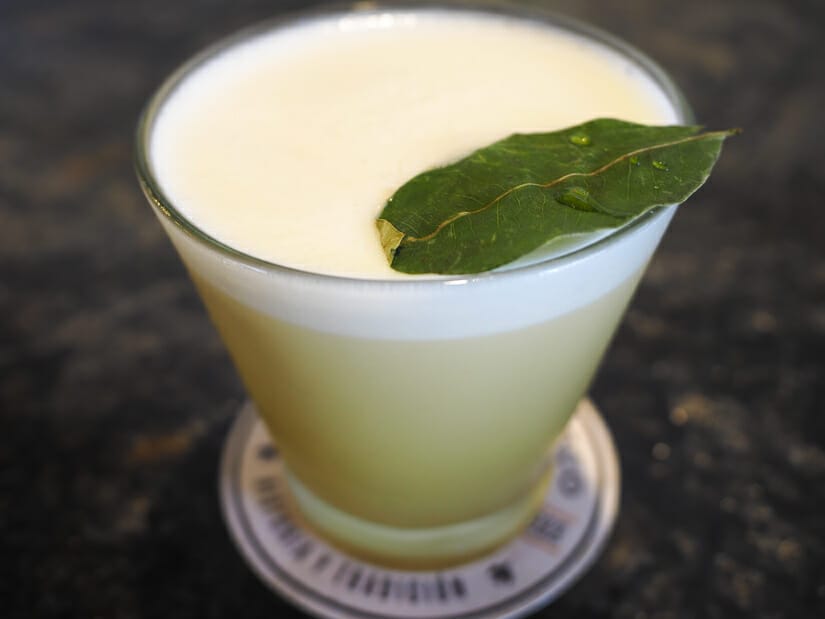
Afternoon
I’m going to give you two different options here. Depending on your timing, there are quite a few more things you could do in the historic center before leaving.
Option 1 would be to continue exploring the below sights in the historic center. Option 2 would be to take a taxi to Larco Museum in Pueblo Libre district, often considered the best museum in Lima, and famous for its collection erotic ceramics.
Going to Larco Museum was my original plan, but I never made it because I wanted to keep exploring the historic center, as follows.
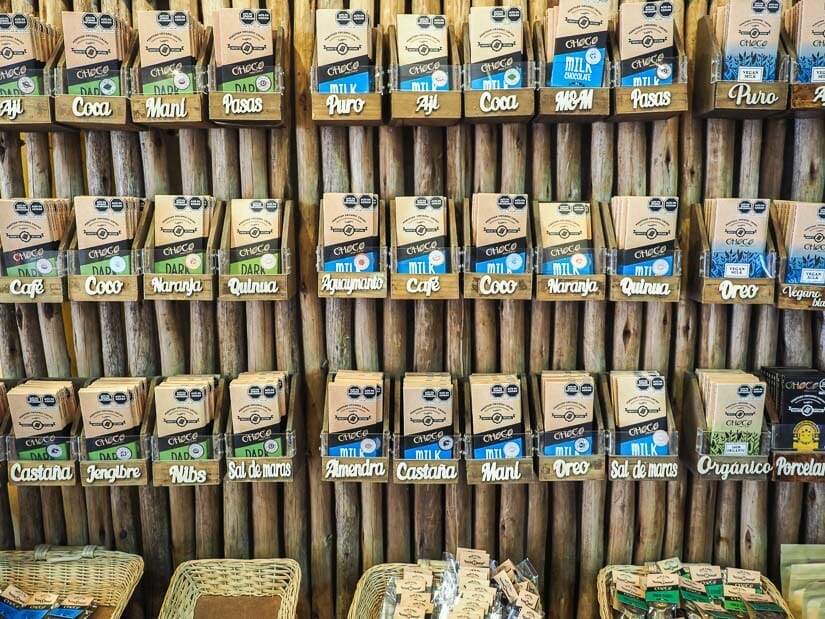
After lunch, I popped in to ChocoMuseo, a famous chocolate shop chain that also has branches in Miraflores, Cusco, Ollantaytambo, and even outside of Peru. There you can purchase chocolate bars, liquors, teas, candles, soap, and more. This Lima branch is right next to Museo del Pisco.
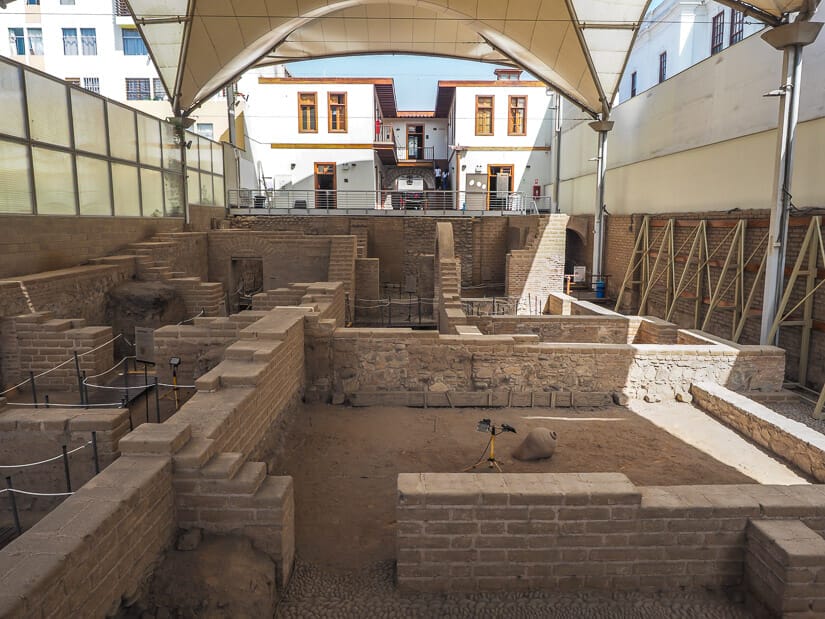
Nearby, Museo del Sitio Bodega y Quadra is an excavated 17th century colonial home, once the home of Spanish merchant Thomas de Bodega y Quadra and his son Juan Francisco, who was an early explorer on the west coast of Canada.
Entrance is 4 soles and you can walk right through the excavation site.
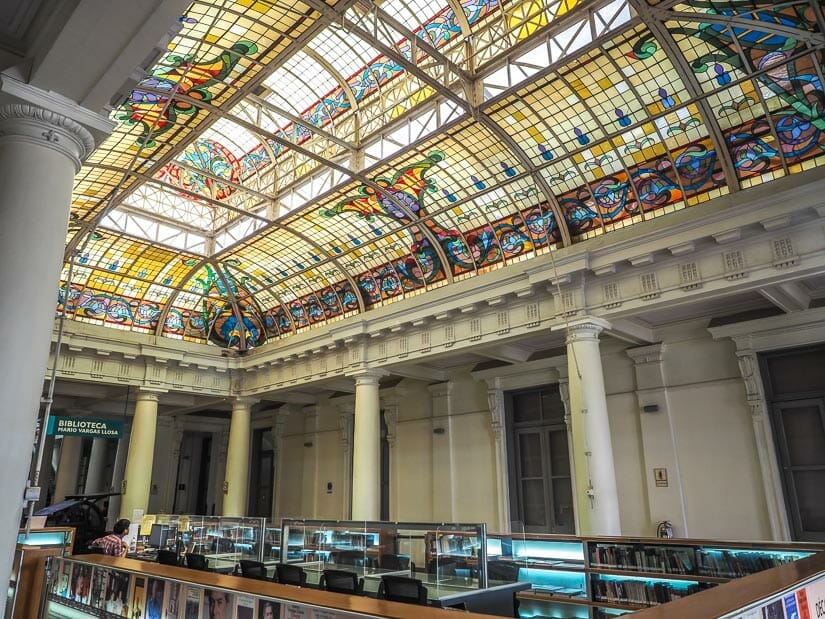
Also nearby, Desamparados Station is an abandoned but very beautiful train station. Built in 1912, it was the centerpiece of the continent’s first railway line. It now houses the Casa de Literature Peruana, including a small library and art gallery. Entrance is free.
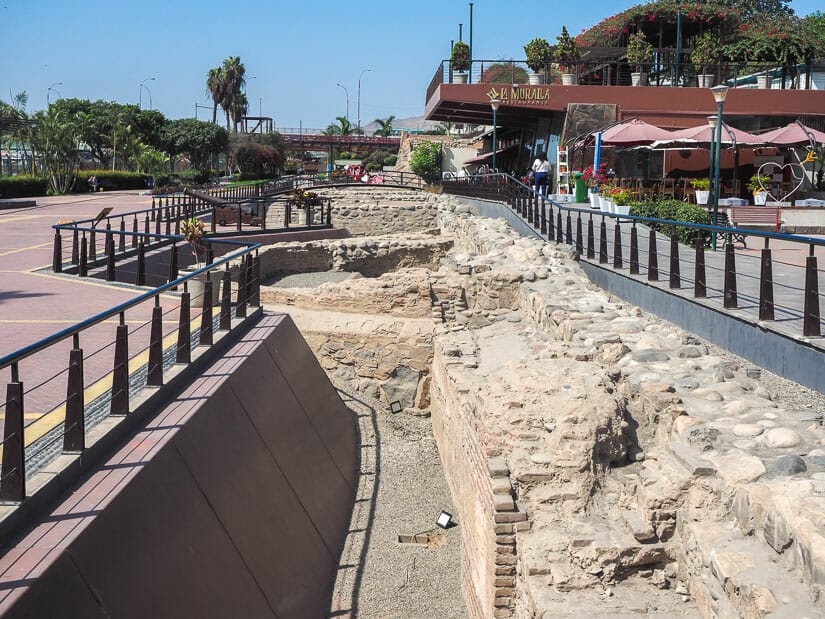
Behind the station is Parque La Muralla, where you can see remains of a 17th century wall that protected the city, a statue of Pizarro riding a horse, and views to a colorful neighborhood built on a cross-topped hill across the river.
Going west from Plaza Mayor, Portal des Escribanos is a lovely pedestrian street with a few statues. One block to its north, watch for the bronze lion on the south-side door of the Casa de Correos y Telegraphos (Post Office). In the past, people could deposit letters into the lion’s mouth.
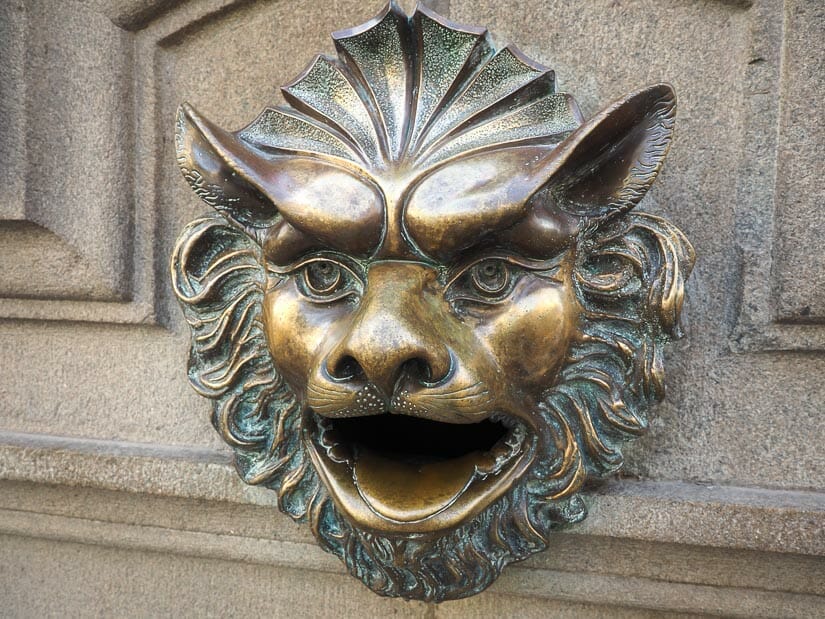
The Convento de Santo Domingo is another convent that you can consider visiting. The rococo tower was under construction when I visited, but inside is still open and beautiful. A map is included with the 10 soles entrance fee (the convent is quite large).
The main highlight here is the relics of three important saints: Rose of Lima (seen on the 200 soles banknote, first saint in Latin America), San Martin Porres (first Black saint), and John Marcias.
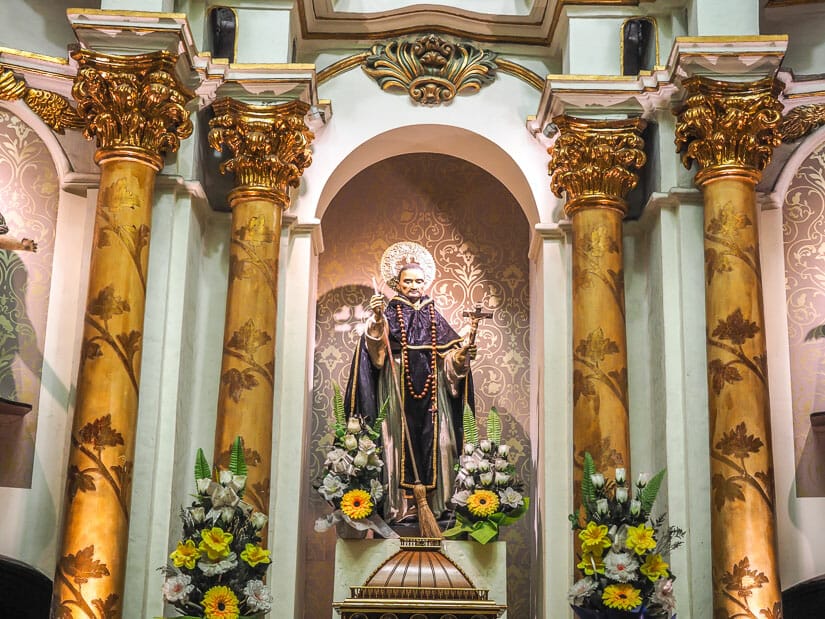
Also, the University of San Marcos, the oldest university in the Americas, was founded right here in the convent’s chapter room. The library on site is incredible.
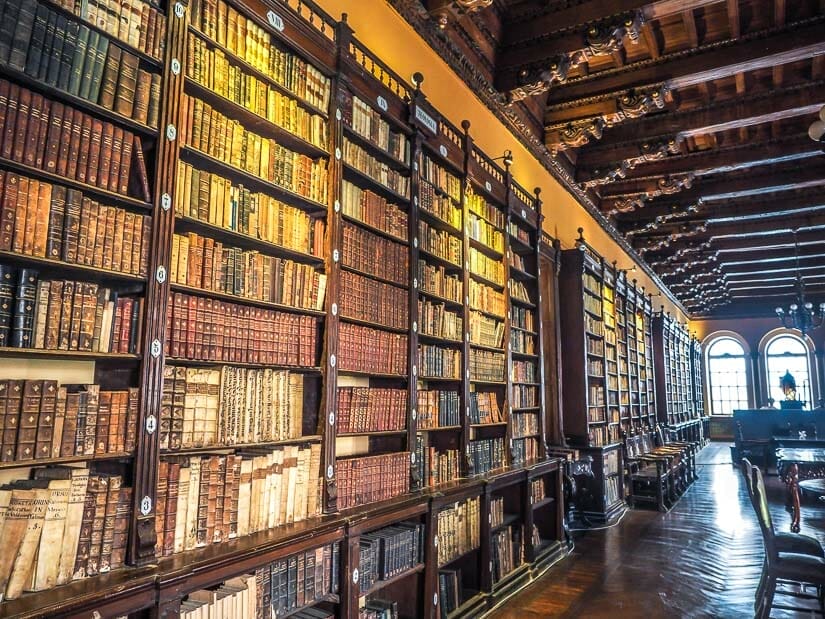
Traveling now toward the south, I clocked the incredible exterior of San Augustin Church. This very busy style is a variant of Spanish baroque called Churrigueresque. Then I headed over to Iglesia de la Merced, another pretty one with a statue of Virgin Mary with her arms outstretched on the facade.
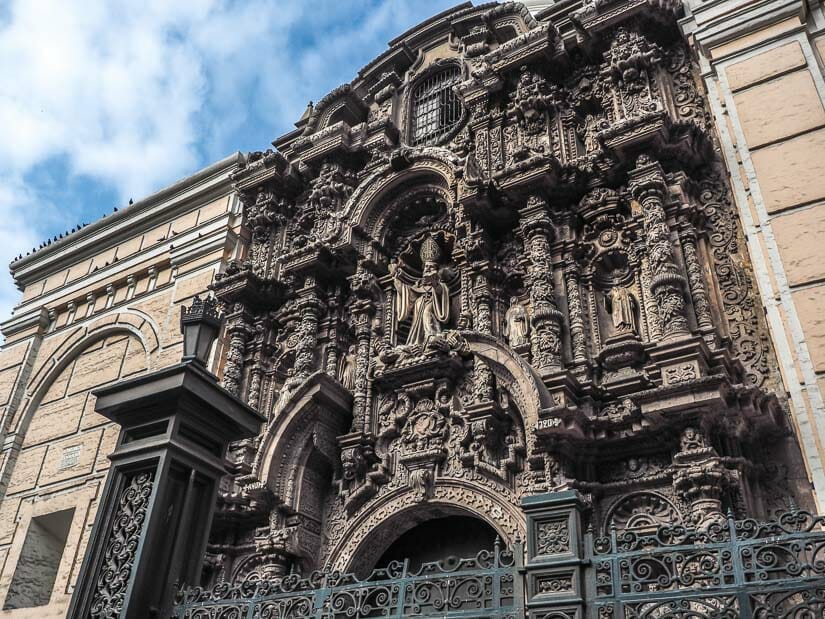

Iglesia de la Merced is on Jirón de la Unión, a beautiful pedestrian street that was once the most important aristocratic meeting place in the city. The street connects Plaza Mayor to Plaza San Martín – follow it south until you reach the latter.
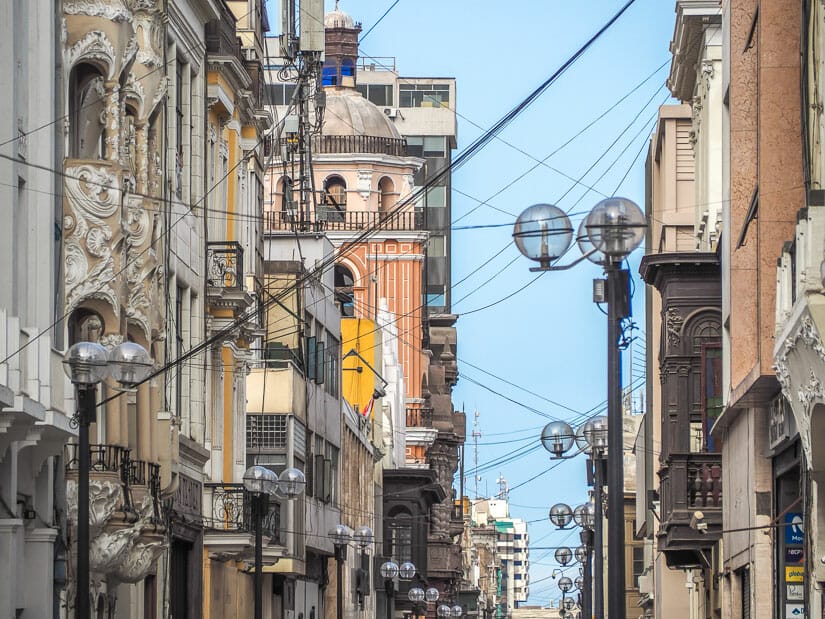
If you’ve got lots of energy, consider a side trip from this point to Barrio China (Chinatown) and Mercado Central (the largest market in Lima). I did, but in retrospect, I feel they weren’t worth the extra walking time – around 30 minutes there and back.
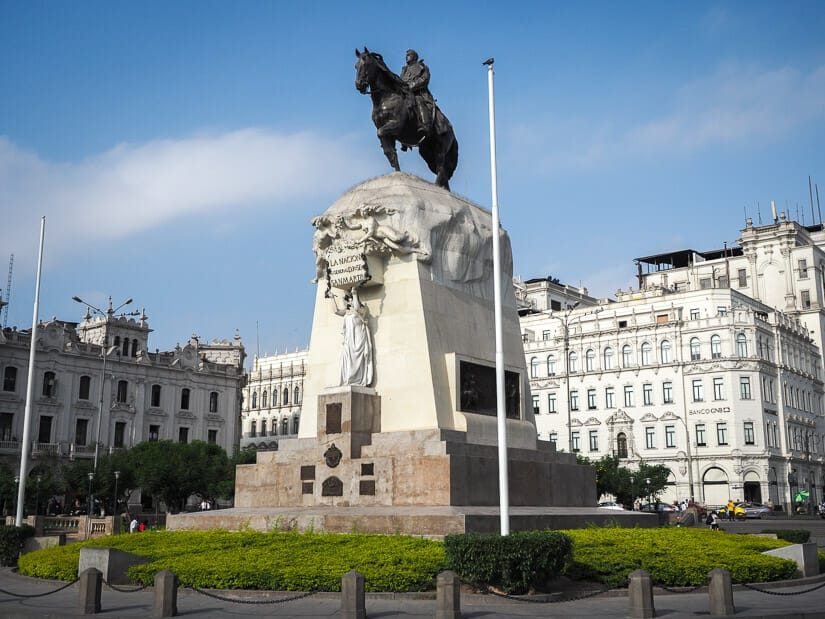
Plaza San Martín is considered one of the most beautiful squares in South America. It was built for Peru’s centennial celebration in 1921, with a monumental statue of the Argentinian liberator San Martin in the middle and French-style neoclassical buildings all around.

Gran Hotel Bolivar Lima on the western side of the square is the city’s most famous historical hotel. It’s practically mandatory to visit the bar here for a pisco sour – both Ernest Hemingway and Walt Disney did!
If you’re especially thirsty, go for the “catedral” sized one (48 soles). Besides the classic lime, flavor choices include cinnamon, maracuya, coca, camu camu, grape, and raspberry.
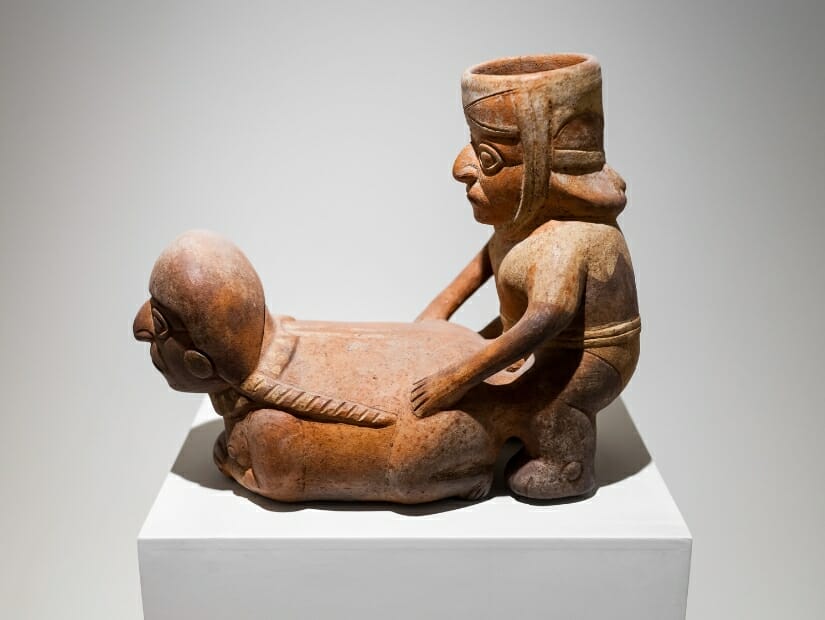
At this point, you’ll need to look at your watch and make a decision. I’ve you’ve moved quickly, you may still be able to sneak in Larco Museum before dinner – keep in mind that there’s an excellent restaurant at the museum.
Although I had originally planned to go, I gave Larco Museum a skip (I already saw too many museums in Cusco) and continued walking south from Plaza San Martín.
I walked all the way to Parque Juana Alarco de Dammert, where I saw some Peruvian punks and hippies hanging out in the park. I also took a peek at the murals on the backside of the Italian Art Museum (Museo de Arte Italiano).
Next, I visited the Park of the Exhibition, which has several buildings which were constructed for the Lima International Exhibition of 1872. I had a heck of a time finding the entrance to this huge, mostly fenced park. I eventually found an entrance on the south side of the park.
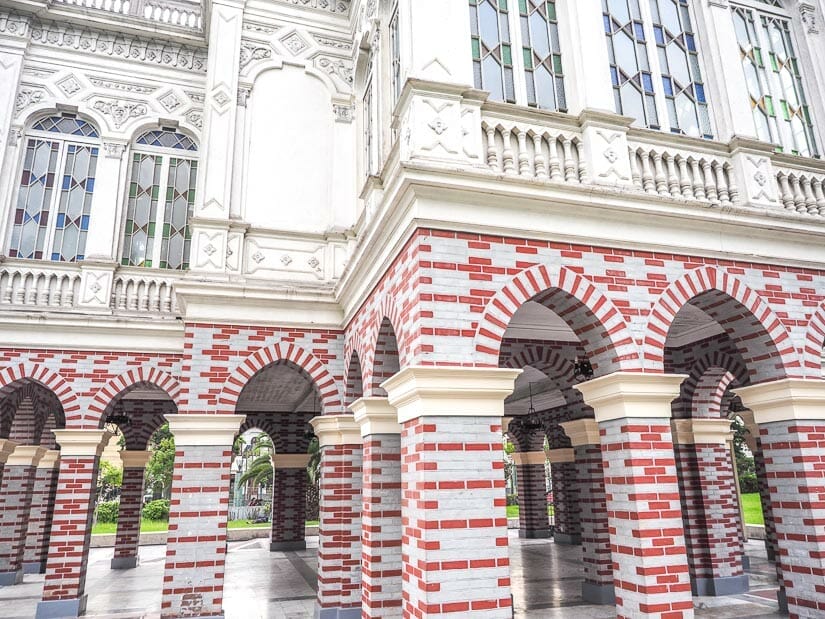
Some highlights in the park are the Byzantine Pavilion, Moorish Pavilion, Fuente China (Chinese fountain), and Japanese Garden. The Museo de Arte Lima is on the north side of the park.
The park seems to be the go-to place for local couples to snuggle, and the fence around most of the park means that the park is a quiet oasis free of crowds.
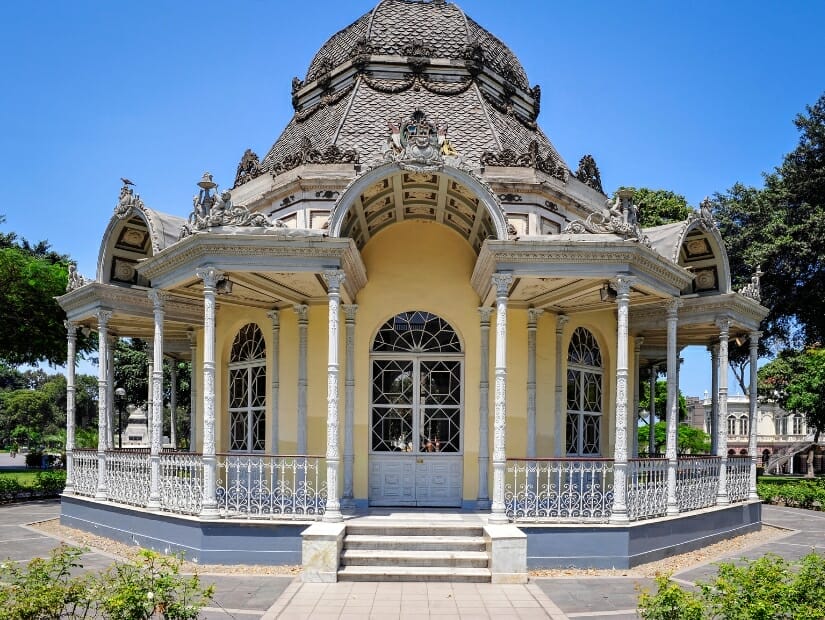
From there, I continue walking south (yes, my feet were getting very tired by this point) for my final stop in the area: the Magic Water Circuit (Circuito Mágico del Agua) in another huge park.
This is considered the largest collection of water fountains in the world. There are 13 major water fountains here, including a water tunnel you can walk through. The fountains start at 3 PM, but you really want to stick around until dark, when they are all lit up.
This is very much a family attraction, with tons of kids running around (there’s at least one fountain they can play in). Entrance is 3 soles.
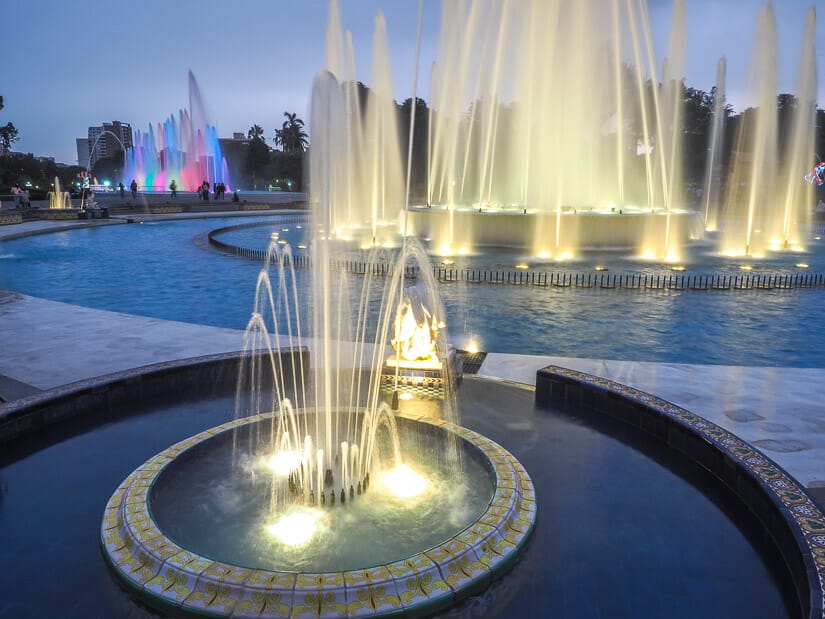
Evening
After waiting around Magic Water Circuit until sunset, I took a taxi from the only entrance/exit, on the north side of the park, back to Miraflores.
I got off the taxi at Miraflores Central Park. This consists of two connected parks, Parque 7 de Junio and Parque Kennedy. It feels like the center of Miraflores and is bustling with people at night.
In the center of Kennedy Park, watch for Picarones Mary, which was featured on the Netflix documentary Street Food: Latin America. If you never got a chance to try this delicious dessert in Peru, do it now!
There’s also another branch of ChocoMuseo beside the park.
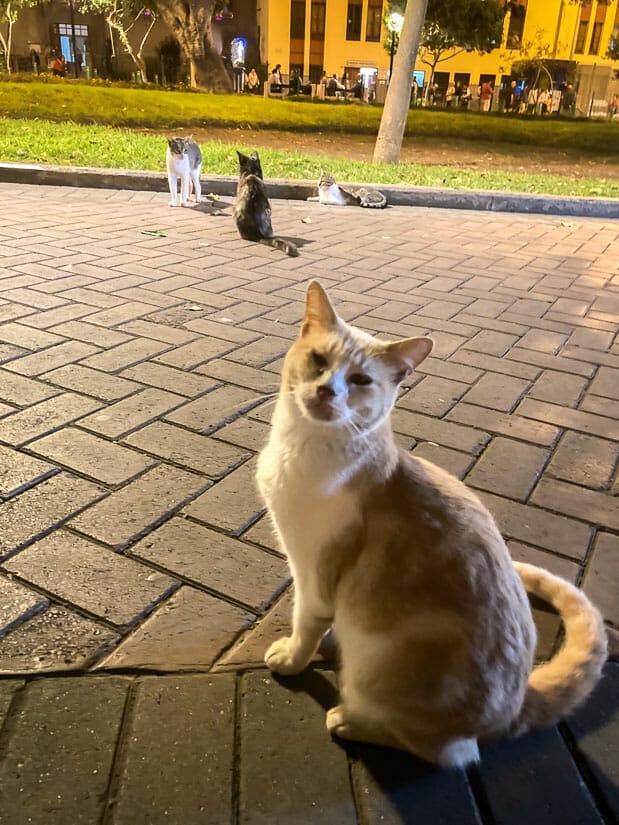
But the best part: the park is totally filled with cats! They’re everywhere and are a big hit among locals and visitors alike. I took far more pictures of them than is necessary because, you know, cats!
After the huge amount of walking I did this day, I didn’t have much energy left for exploring in the evening. All I wanted to do was eat and crash.
Luckily, Miraflores (along with Barranco, which we’ll visit tomorrow) is the epicenter of dining in Lima. I had been lost in planning where to eat in Miraflores – I had a short list of over a dozen restaurants I want to try there, but only a few Miraflores meals in my itinerary.
You’ll probably want to do your own research for such an important matter. But in the end, for this meal, I went with the no frills Cevichería Miramar Miraflores for some local ceviche and beer before calling it a day.
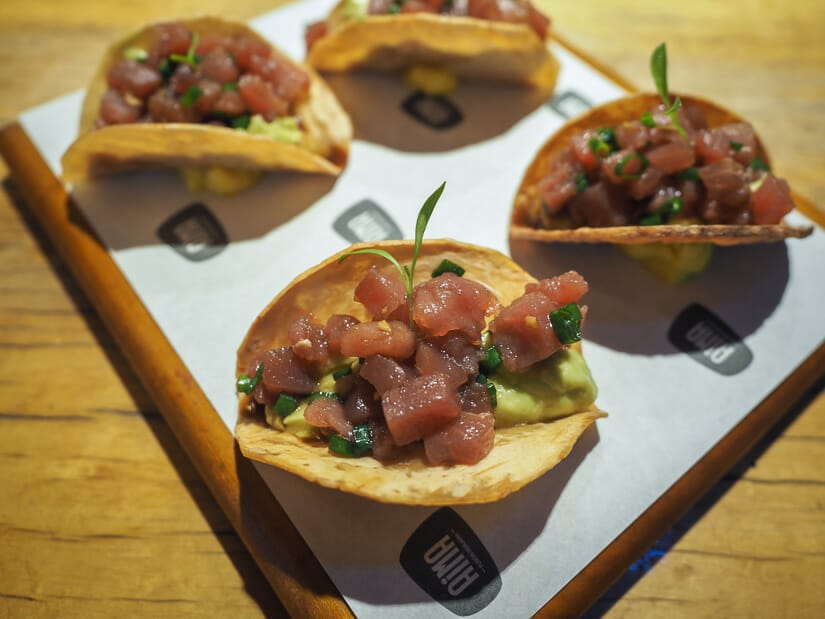
The night before (just after I flew into Lima), I had also visited Mercado 28 Miraflores, a kind of trendy food center with various bars and small restaurants in a covered hall. There I tried a platter of mini causas and raw fish tacos (see above photo) at AIMA. If I weren’t traveling alone, it’s the kind of place I’d love to spend an evening with a few friends!
Another restaurant I has shortlisted included Punto Azul for seafood. Rafael and Maido, considered two of the best restaurants in the world, are also in Miraflores.
If you need a good beer, head to Nuevo Mundo Bar Lima by the park.
Lima Day 2: Miraflores, El Malecón, and Barranco
On my second day in Lima, I had another big day of walking, but you could easily shorten this with a few Uber rides.
Morning
I started my day by walking from my hotel in Miraflores to Huaca Pucclana (around 20 minutes).
Huaca Pucclana is one of Lima’s two famous adobe pyramids dating to the Lima Culture (AD 200 to 700). The other is Huaca Huallamarca in San Isidro district further away.
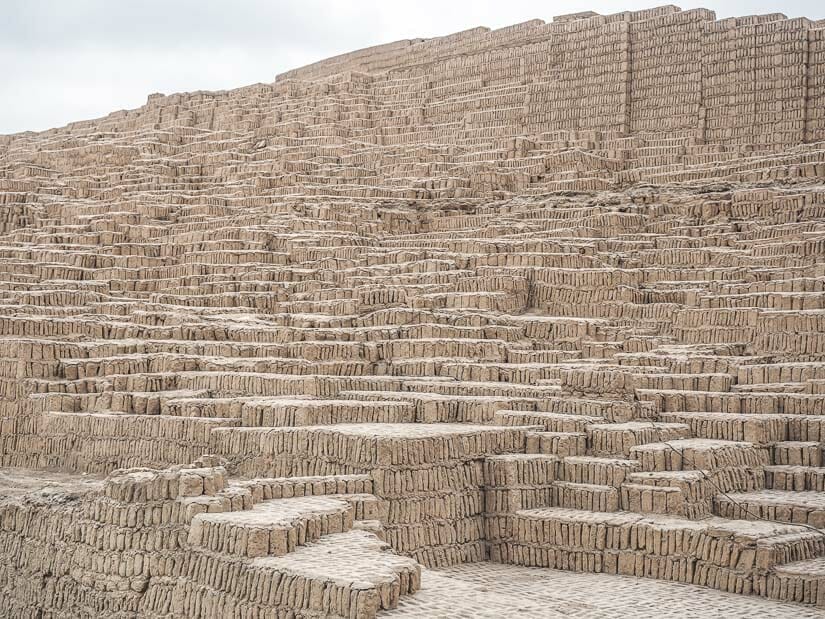
To visit this pyramid, you have to join a tour (15 soles), which you can book online here. The form is in Spanish but easy enough to fill in using GoogleTranslate.
It is usually closed on Tuesday and Thursday, but on the week I visited, it was actually closed on Wednesday instead of Thursday, so make sure to check the schedule when making your plans. Unfortunately, they only seem to release the schedule about a month in advance.
Is it worth the trouble, though? Well, I thought the pyramid was pretty cool, and I did learn a lot on the one-hour tour (bring coins for tipping the guide).
And yes, you do get to climb to the top of the pyramid. I joined the earliest English tour of the day (9:30 AM).
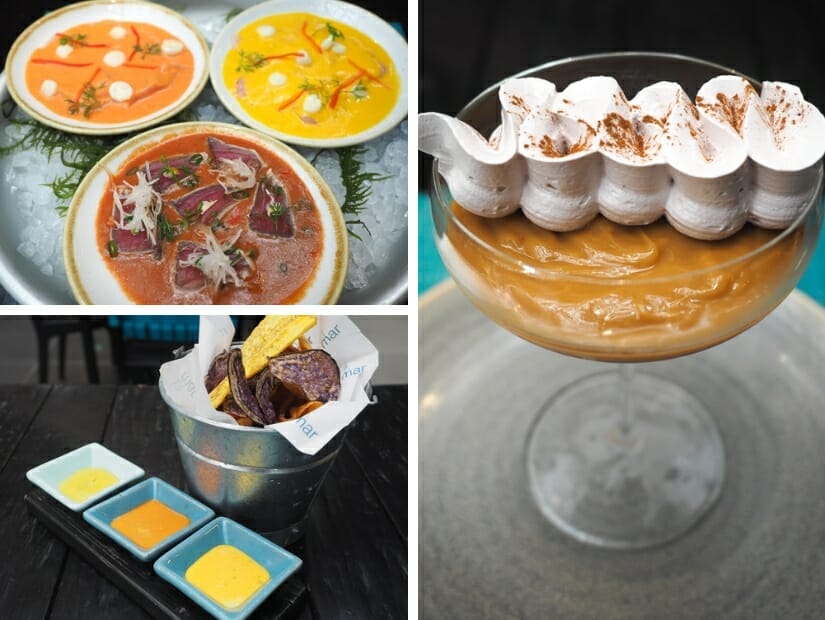
After my tour, I had a little time to kill, so I slowly made my way to a restaurant I had carefully chosen for lunch. This was La Mar Cevichería Peruana, a popular seafood restaurant created by Gastón Acurio, Puru’s most famous chef.
The restaurant is first-come-first serve and fills up immediately after opening at noon – luckily I was in line before they opened.
I enjoyed the free appetizer of root vegetable chips with three dipping sauces, an excellent cocktail, and a combination platter of three different tiraditos – slices of raw fish is sweet / sour sauces.
For dessert, I had Suspiro de Limeña, a thick caramel pudding topped with port-flavored merengue. This was my favorite part of the meal!
Afternoon
I spend most of the afternoon walking the famous Malecón, a long series of connected clifftop parks overlooking the Pacific Ocean, mostly in Miraflores but going all the way down to Barranco.
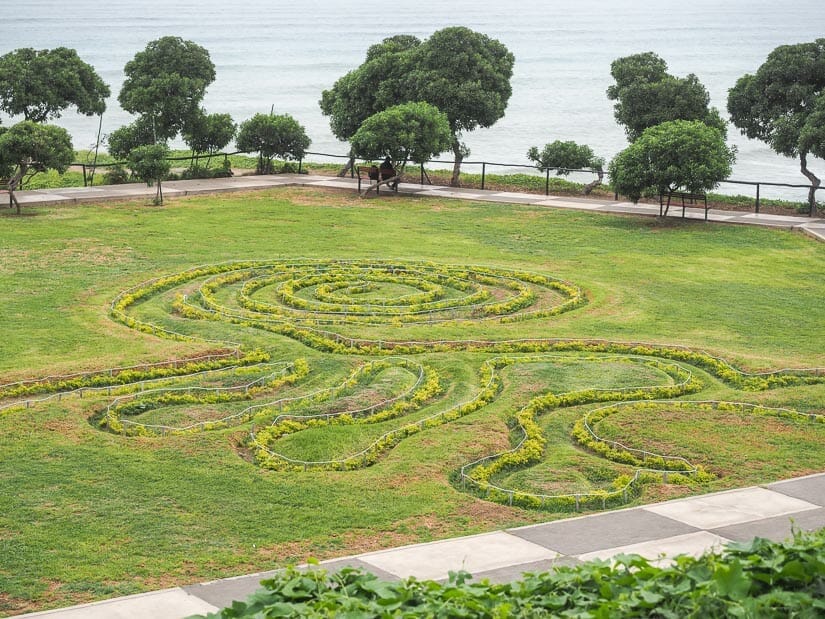
Coming from La Mar, I entered the Malecón at Parque María Reiche, which is notable for its Nazca-like lines. There are more parks north of here, as well as the Lugar de Memoria, a museum dedicated to the 1980 to 2000 conflict in Peru.
But instead of going north, I veered south from Parque María Reiche, with a long series of parks to cross before reaching my destination, Barranco.
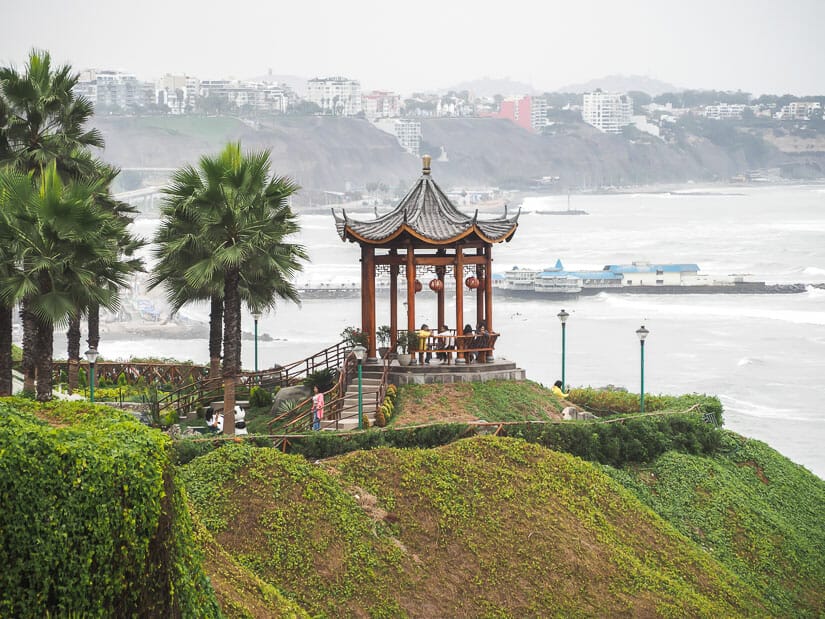
After passing a skatepark, I reached Parque Grau, which has a monument to a naval leader. Parque Chino features a Chinese Pavilion, where I even saw some local teens taking cosplay photos. After that is Parque El Libro, with more statues.
Parque El Faro features a black-and-white Marine Lighthouse (Faro de la Marina). It is also a popular launching spot for paragliders.
Going south from there, I looked down on the long dock out to Rosa Nautica, a classic Lima restaurant on the sea. You can see the blue and white building in the above and below photos.
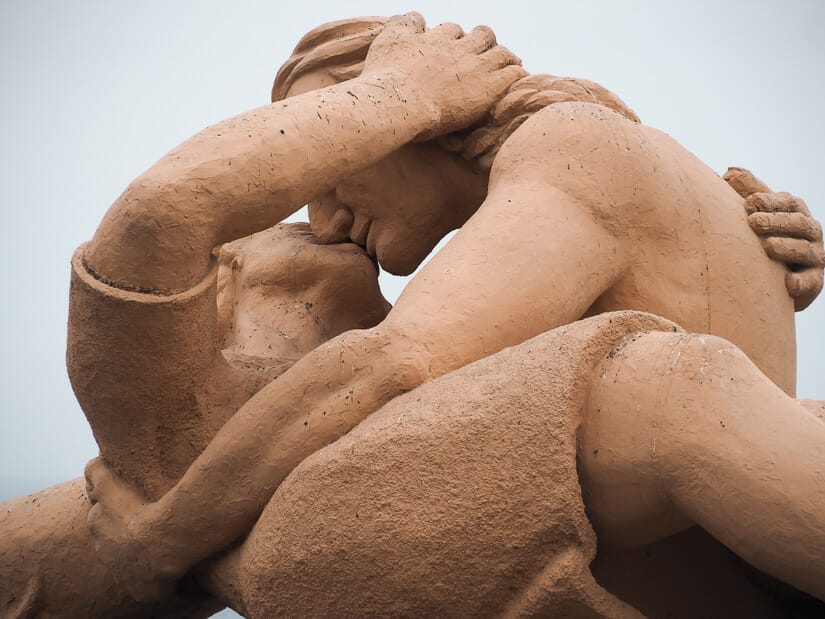
The most popular park on the whole Malecón is Parque del Amor (Love Park), with the famous El Beso (The Kiss) statue by Limeño artist Victor Delfín. It depicts Delfín kissing his wife.
The park also has Gaudi-like benches with ceramic mosaics. After that, there is a modern version of the Intihuatana stone from Machu Picchu and Pisac ruins and a Virgin Mary statue in Parque Sunset.
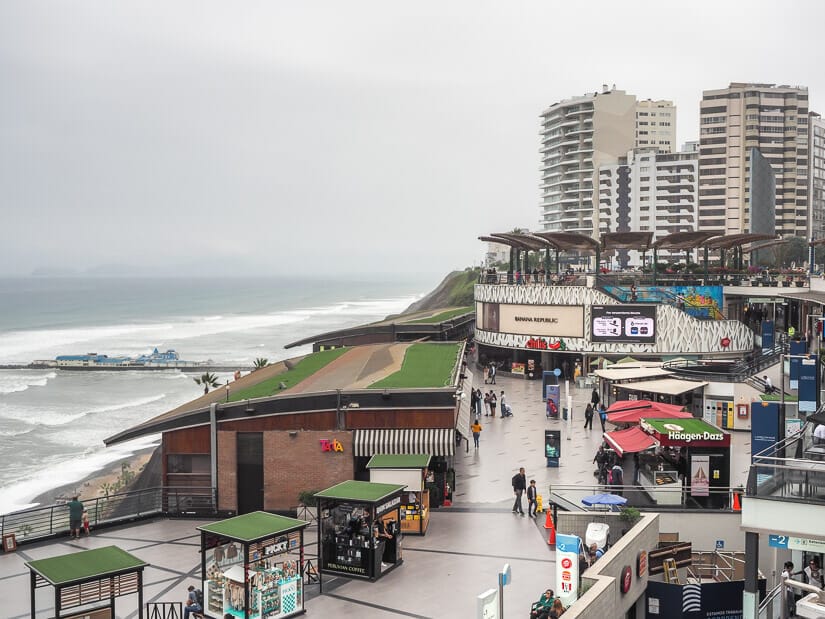
Next, I reached Larcomar, another famous Lima institution. This is a shopping mall on a clifftop facing the sea, with lots of cafés and restaurants.
In retrospect, I kind of wish I would have stopped my walk at Larcomar and taken a taxi the rest of the way to Barranco. Instead, I walked the whole way, but it was another 30 minutes without much to see, and the Malecón is soon interrupted by a major freeway, so I had to veer inland.
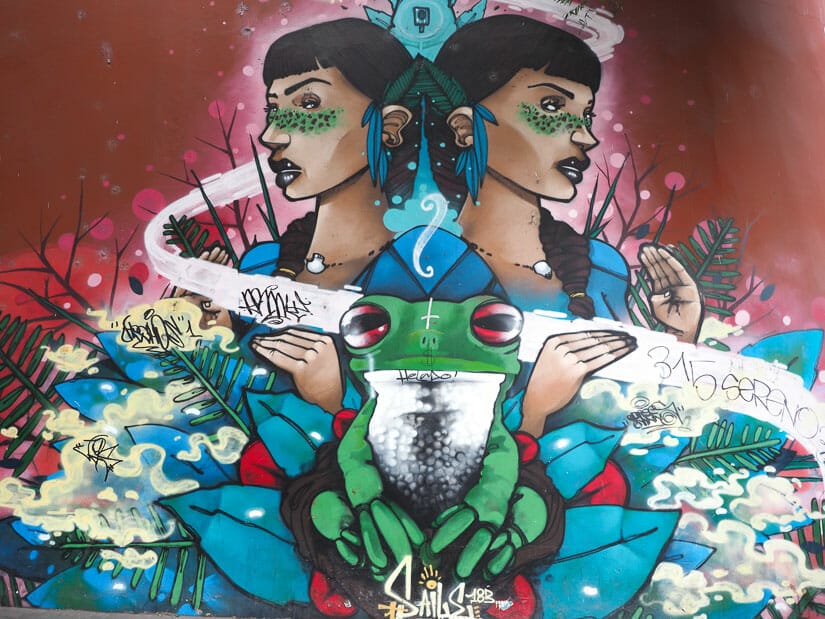
Barranco is often described as “Bohemian”. It used to be a fisherman’s district, but Limeños started going there in the 1800s for its sea views and beaches. There even used to be a funicular there. The district gained a reputation as an artists’ district, and today the area around Municipal de Barranco Park has atmospheric lanes, cool cafés, bars, and restaurants, and lots of street art.
Arriving in Barranco, I passed by the Lima Museum of Contemporary Art then turned down Av. Sáenz Peña to see the pretty mansions before beelining for the Park.
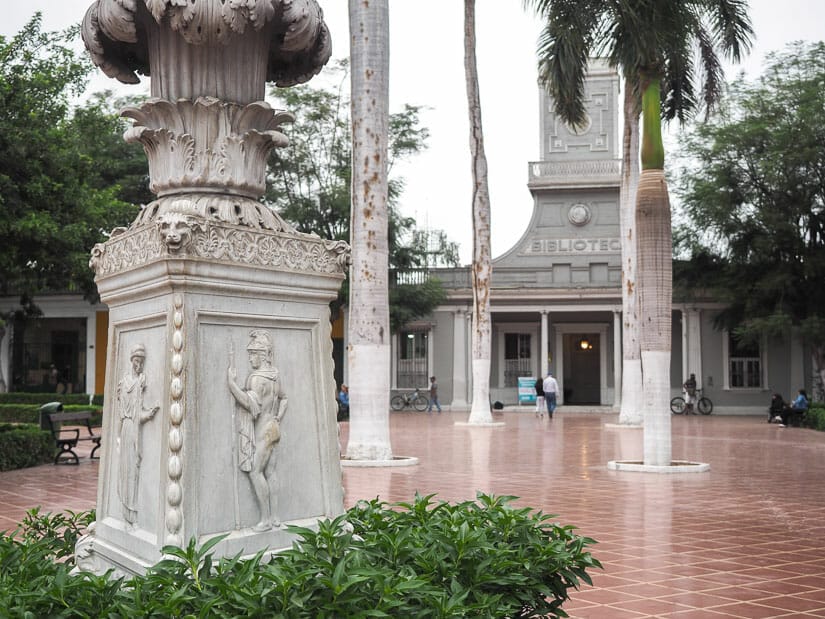
Municipal de Barranco Park (Plaza de Armas Barranco) is a small but pretty square with a few statues, a church to the north, and a beautiful library dating to 1922 to the south. I recommend getting ice cream at Crem dela Crem next to the library!

The top sight in the area is the Bridge of Sighs (Puente de los Suspiros), a pedestrian bridge over Bajada de los Baños, a stone path down to the coast. Fishermen used to walk the path down to the sea.
The famous story goes that in a girl once fell in love with a street sweeper. Her father didn’t approve, so she passed her days gazing out at the path and sighing. In summer, consider walking all the way down to the beach.
The whole area oozes with romance and has inspired many criolla songs, most notably El Puente de los Suspiros by Chabuca Granda. Besides the Bajada de los Baños, make sure to also walk down Calle la Ermita, which has been called Barranco’s most charming street. You’ll pass Iglesia la Ermita, which was destroyed by an earthquake and never repaired.
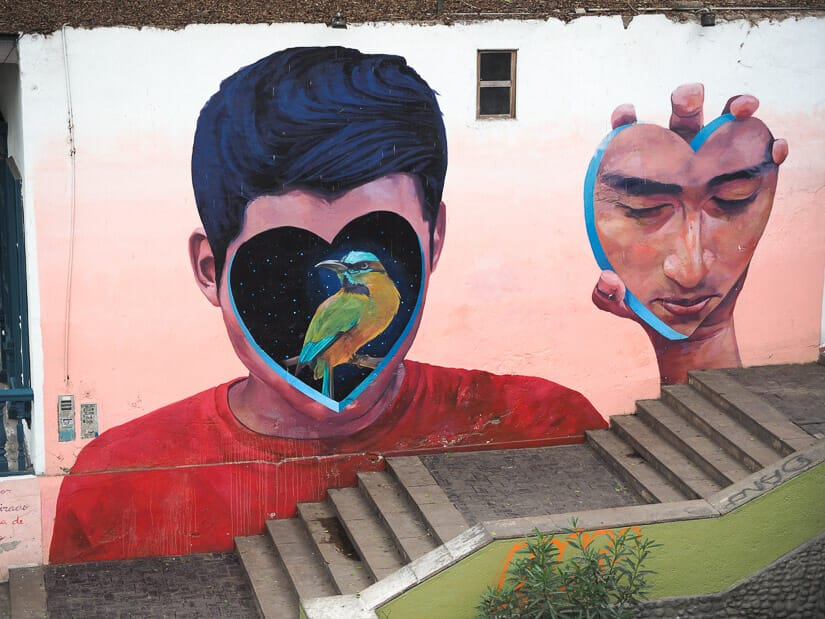
At the end of Calle la Ermita, there’s a viewpoint of the sea and criollo musicians who will play for you for a fee. Try La Posada Del Mirador here for a drink/meal with a view.
Some of the best street art in Lima can be seen in this area. The most famous mural is Mural El Hogar De un Suspiro by Jade Rivera, near Puente de los Suspiros. A Jade Rivera gallery is nearby.
Other murals marked on GoogleMaps include Mural Space Jam and this one, but you’ll find more if you just explore, especially on the small staircases leading up from Bajada de los Baños and at Puente Montero Bernales.
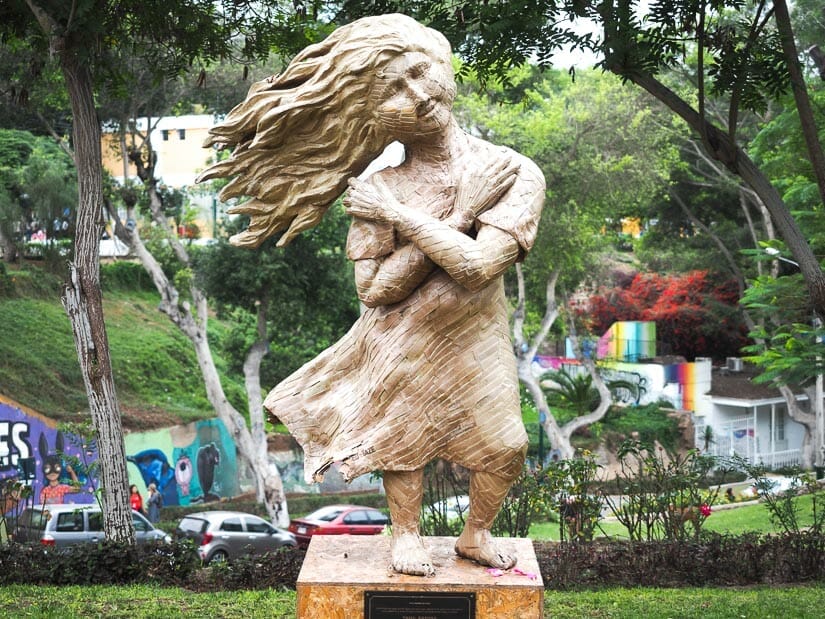
In the neighborhood north of the plaza, there are countless hip bars and restaurants.
I stopped at Ayahuasca for a fancy cocktail, El Cacaotal to buy chocolate from all over Peru, Barranco Beer Company for a pint, Invictus Taproom for another, and Red Cervecera for yet another – the first is a classic institution, the second is a newer one with some seriously good beers, and the last has more of a bohemian punk vibe.
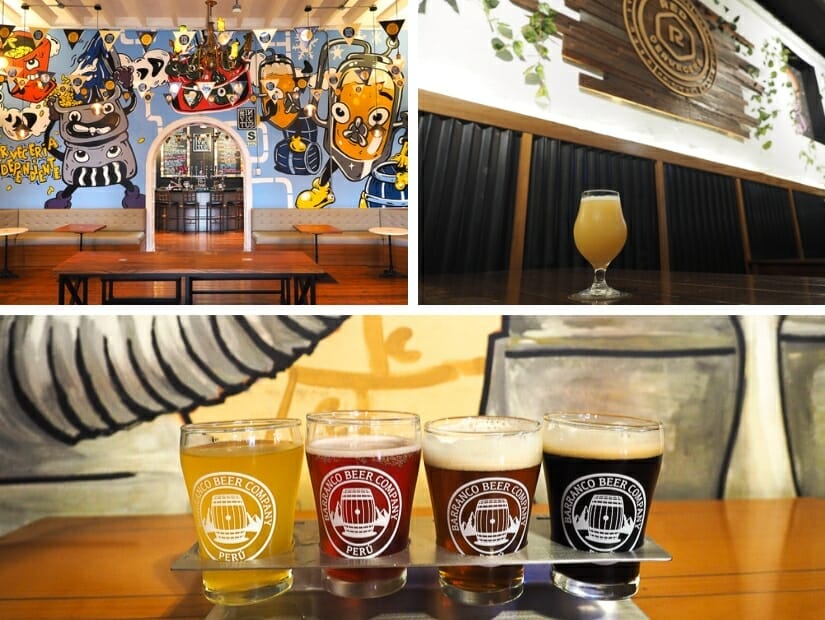
As you may have noticed, I focused more on drinks than food. Somewhere in there I did actually eat something too, but nothing worth reporting here.
Some Barranco restaurants on my shortlist that I never made it to include El Muelle Cevichería for ceviche, Canta Rana for classic Peruvian, or Bodega Piselli for a very traditional local bar.
Central, considered the second-best restaurant in the world, is a few blocks south of the plaza. I tried walking by but couldn’t even sneak a peek over the huge fence.
From there, I caught a taxi back to my hotel to prepare for an early morning ride to the airport. Farewell, Peru, until we meet again!
Thanks for reading! If you need some assistance of advice for planning the rest of your Peru trip, consult with a Peru expert at Go Ask A Local.

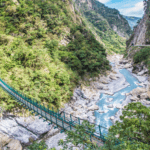
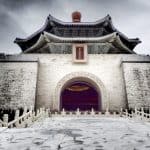
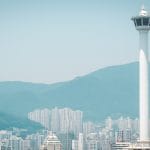
Hi Nick. My family (husband and 2 kids 10 & 13) just returned from Peru and I wanted to thank you for all your tips! I constantly went back to your blog to find restaurant recommendations, must see places and general information. It was so helpful and your blog made our trip so much better. Thanks for taking the time to document your experiences so others can learn from them 🙂